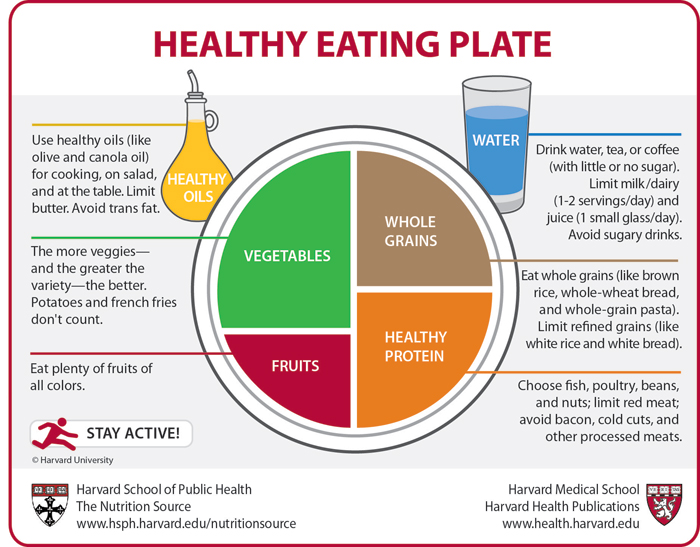Vegetarian Recipes for a Healthy Eating Plate
Harvard’s Healthy Eating Plate has a new version, a meatless one. Acclaimed cookbook author Mollie Katzen and Harvard University Dining Services have cooked up this new vegetarian version.
Cozy Red Lentil Mash, Thai Eggplant Salad with Coconut Tofu Strips, Garlic-Braised Greens and Roasted Squash with Pomegranate, “Simple Celery Date Salad” or try the fiber-rich “Fantastic Bulgur Dish“.
The new Healthy Eating Plate is created by nutrition experts at Harvard School of Public Health. The Healthy Eating Plate can be your blueprint for planning a healthy balanced meal, and it fixes key flaws in the U.S. Department of Agriculture’s MyPlate.
Here’s a rundown for following the Healthy Eating Plate:
Fill half of your plate with vegetables and fruits.
The more color, and the more variety on this part of the plate, the better. Potatoes and French fries don’t count as vegetables on the Healthy Eating Plate, because they are high in fast-digested starch (carbohydrate), which has the same roller-coaster effect on blood sugar and insulin as white bread and sweets. These surges, in the short term, can lead to hunger and overeating, and in the long term, can lead to weight gain, type 2 diabetes, and other health problems.
Save a quarter of your plate for whole grains—not just any grains:
Whole grains—whole wheat, brown rice, and foods made with them, such as whole wheat pasta—have a gentler effect on blood sugar and insulin than white bread, white rice, and other so-called “refined grains.”
Put a healthy source of protein on one quarter of your plate:
Chose fish, chicken, beans or nuts. An egg a day is okay for most people, too (people with diabetes should limit their egg intake to three yolks a week, but egg whites are fine). Limit red meat—beef, pork, and lamb—and avoid processed meats—bacon, cold cuts, hot dogs, and the like—since over time, regularly eating even small amounts of these foods raises the risk of heart disease, type 2 diabetes, and colon cancer.
A new study from Harvard School of Public Health (HSPH) researchers has found that red meat consumption is associated with an increased risk of total, cardiovascular, and cancer mortality. The results also showed that substituting other healthy protein sources, such as fish, poultry, nuts, and legumes, was associated with a lower risk of mortality. The study will be published online in Archives of Internal Medicine on March 12, 2012.
Use healthy plant oils.
Use healthy vegetable oils, like olive, canola, soy, corn, sunflower, peanut, and others, in cooking, on salad, and at the table. Limit butter, and avoid unhealthy trans fats from partially hydrogenated oils.
Drink water, coffee or tea.
Complete your meal with a glass of water, or if you like, a cup of tea or coffee (with little or no sugar). Limit milk, dairy products, juice, sugary drinks.
Stay active.
Staying active is half of the secret to weight control. The other half is eating a healthy diet with modest portions that meet your calorie needs.


